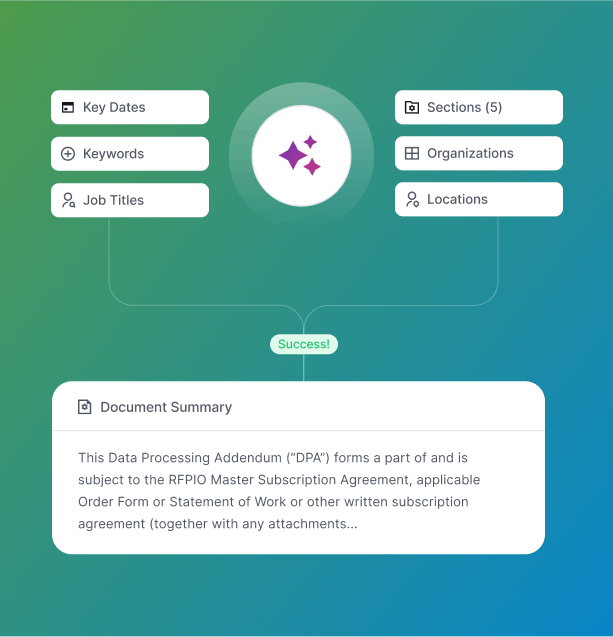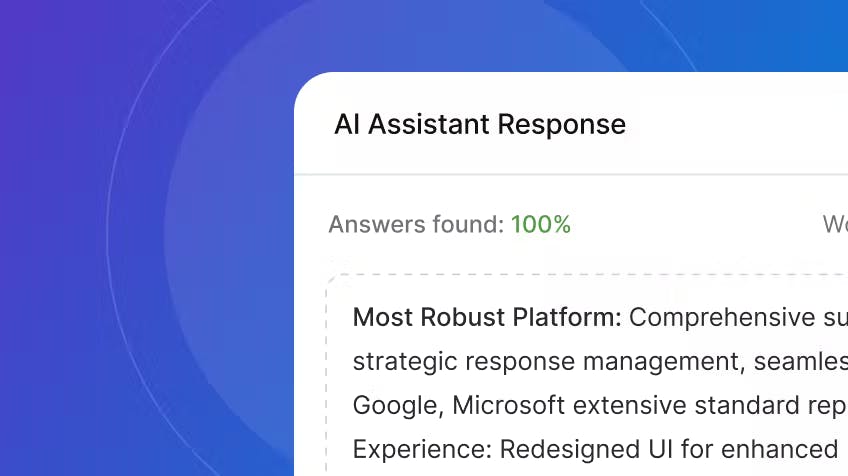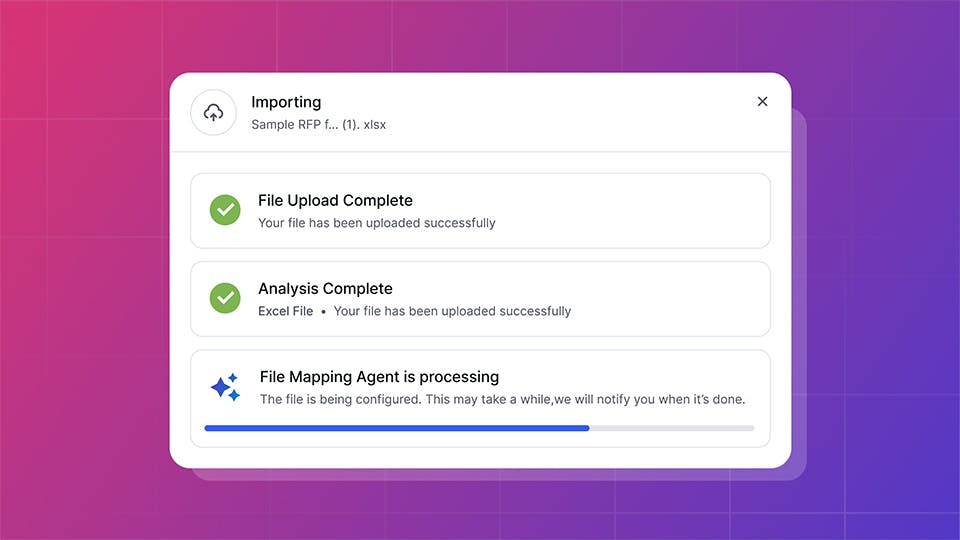Responding to an RFP can often feel like a marathon at sprint pace. The deadlines are tight, the stakes are high, and the requests continue to multiply. Today, RFPs, RFIs, DDQs, and security questionnaires all demand accurate, compliant, and compelling responses. It’s a lot for any team, and these increased demands all come with less time and more scrutiny than ever before.
Winning isn’t about simply filling in the blanks. It’s about showing credibility, clarity, and differentiation. Here are practical RFP best practices, organized into two essential areas: content and process.
RFP response content: a section-by-section guide
The number one rule of all RFP responses is to make it about the customer. Every section of your proposal should focus on their challenges, their goals, and how you’ll help them succeed.
Remember, the people reading your RFP are busy and juggling competing priorities. They’re not looking for a sales pitch; they’re looking for proof. The best responses are:
- Focused on the customer’s problem and how you solve it
- Concise and free of filler
- Relevant to the project scope, with upsell content saved for later
Let’s break down each section of the RFP response and how to approach it.
RFP cover letter
Goal: Make a strong first impression and show you understand what matters to the buyer.
How to do it: Keep your RFP cover letters warm, human, and direct. Show enthusiasm about the opportunity, restate their key objectives in your own words, and quickly connect those objectives to your solution. This is not the place for generic pleasantries. Be specific, be empathetic, and keep it all about them.
Executive summary
Goal: Provide a clear, high-level snapshot that could stand on its own if it’s the only page an executive reads.
How to do it: Tailor it. Demonstrate that you understand why they issued the RFP. Perhaps they’ve outgrown their current vendor, or they require greater speed and accuracy. Address those needs head-on, highlight the measurable outcomes you deliver, and keep it easily digestible.
Project implementation plan and schedule
Goal: Help the customer envision a smooth path forward with you as their partner.
How to do it: Be detailed and reassuring. Outline milestones, timelines, and what a typical journey from contract to go-live looks like. Use their provided timeline as an anchor. Introduce the team members they’ll work with and clearly state what you’ll need from their side. This can be documentation, training input, or system access. The more concrete and collaborative you are here, the more confidence you’ll inspire.
Contract terms
Goal: Reduce friction and build trust in the contracting process.
How to do it: Anticipate their concerns. Share your contracting steps, who’s involved, and what documentation you’ll need. Proactively include relevant items, such as a completed security questionnaire or standard terms, to expedite the process. Don’t stop at signing. Explain how you’ll support them long-term with customer success resources, self-service tools, and regular check-ins. Make it clear you’re invested in their ongoing success, not just the deal.
Customer references and case studies
Goal: Prove you can deliver with evidence. Don’t rely on promises.
How to do it: Showcase relevant customer stories, complete with metrics, outcomes, and direct quotes. Whenever possible, provide references from organizations similar to the prospect’s industry or size. If appropriate, offer a peer-to-peer reference call. Nothing builds credibility faster than hearing from someone who’s already seen results with your solution.
RFP content best practices

Beyond hitting the goals for each RFP section outlined above, winning RFPs requires great content. We’ve reviewed content from numerous winning RFP response examples, and they all share a few commonalities, which we’ve outlined below in a convenient list of RFP best practices and examples.
1. Centralize your knowledge
Outdated and scattered content is one of the biggest obstacles for proposal teams. High-performing organizations maintain a single, searchable knowledge hub — often through Strategic Response Management (SRM) platforms — so that every answer is accurate, approved, and easily accessible.
2. Write for real humans, not just evaluators
Buyers today expect more than compliance. They want to feel understood. Replace jargon with plain, clear language, and tailor content to demonstrate that you know their specific challenges. Avoid “copy-paste” answers that read generic. Personalization is now table stakes.
3. Keep content fresh and auditable
Your content library should reflect the latest product updates, compliance policies, and customer proof points. Assign clear ownership for reviews, and build a schedule to keep information updated. This not only boosts accuracy but also builds trust with evaluators.
4. Use AI responsibly
AI is now part of the RFP landscape. Buyers are using it to draft and evaluate. Response teams are using it to accelerate their processes. But AI is only as good as the content it draws from. Combine AI with well-managed knowledge and human judgment to ensure quality, context, and compliance.
RFP process best practices
No process is perfect. There’s always room for improvement, even within teams that have tightly refined their RFP process. For example, a highly-skilled and efficient two-person team can respond to one or two RFPs per quarter when working manually.
However, after implementing RFP response best practices and RFP software, the same team can successfully respond to significantly more RFPs in the same time frame. These tips will help you achieve similar results.
1. Clarify ownership early
Misalignment is a recipe for delays. From the outset, define who owns which parts of the response. Proposal managers should orchestrate, but SMEs, sales, and executives all play a role. Clear accountability reduces last-minute fire drills.
2. Qualify before you commit
Not every RFP is worth chasing. Establish go/no-go criteria that evaluate deal size, win probability, and strategic fit so teams invest their time where it counts. High-growth organizations use SRM insights and past win-loss data to make sharper pursuit decisions.
3. Standardize workflows
Templates, style guides, and approval processes speed up collaboration while keeping responses consistent. The right balance of structure and flexibility keeps teams moving quickly without sacrificing quality.
4. Balance speed with strategy
AI and automation can remove repetitive tasks like formatting, tagging, and first-draft writing. But the time you save should be reinvested in strategy: refining win themes, tailoring executive summaries, and sharpening differentiation.
Bringing it all together

RFPs are now far more than just compliance exercises. These lengthy documents have evolved into critical opportunities to influence buyers and generate revenue. The best teams treat them as strategic responses, combining centralized content, transparent processes, and human expertise amplified by AI.
With Strategic Response Management, organizations can move beyond firefighting and into foresight, transitioning from reactive to proactive. They can leverage knowledge into a competitive advantage, align cross-functional teams, and deliver responses that exceed expectations and earn trust.
